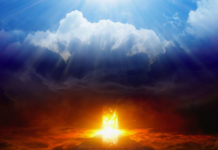What has stripped the seeming beauty
From the idols of the earth?
Not a sense of right or duty
But the sight of peerless worth
~ Miss Ora Rowan
Jamal Jivanjee interviewed me about the message I delivered at the Momentum 2011 Conference. I’m publishing the interview here in three parts. This is Part II. The title of the post is fitting as you will see.
Jamal: You mentioned that we make a big mistake when we try to separate the kingdom of God from the church. There was one statement regarding this subject that you made in the message that really jumps out at me. Here is what you said:
“To separate the kingdom from the church is to separate light from visibility.”
Can you elaborate on this statement a little bit more?
Frank: I give examples of this point in the message itself. It’s also dealt with in a two-part article entitled Kingdom Confusion. But the main point is that Jesus, Luke (in Acts), and Paul all use different language to describe the same thing.
The kingdom – the manifestation of God’s ruling presence – is made known in and through what Luke and Paul call the ekklesia. The ekklesia is the community of the King. It’s the very body of Jesus on earth . . . the kingdom society . . . the divinely-chosen instrument for God’s move on the planet.
Hence, the ekklesia embodies the kingdom, just as Jesus embodies it. You cannot separate the kingdom from the church anymore than you can separate the kingdom from Christ. After all, the church is the very body of Christ.
Dispensational theology separated kingdom from church. And I believe this is profound mistake that has found its way into the bloodstream of the evangelical mind. While kingdom and church are distinct, they are not separate. So it seems to me anyway.
Jamal: In most discussions about the Garden of Eden and mankind’s time there, I have found that there is not a lot of discussion regarding the Tree of Life. Most of the focus seems to be on the other tree which is the tree of the knowledge of good and evil. Why do you think that is? Here is a statement that you made in the message that I think is vitally important:
“The tree of life is on the earth again.”
Can you elaborate on this a bit more?
Frank: I’m indebted to Watchman Nee, T. Austin-Sparks, Stephen Kaung, and DeVern Fromke for shaping my understanding of the Tree of Life. I understand the Tree of Life to be the visible reservoir for imparting God’s own uncreated, eternal life into human beings.
It was the means by which Adam, Eve, and their descendants were to partake of God’s life and fulfill the Adamic commission to express God’s image and exercise His reign. This was not an individualistic commission, but a collective one. Note the words “let them have dominion” and “be fruitful and multiply” in Genesis 1.
John 1 is a replay of Genesis 1. And we find the same corporate element there as well. “And of His fullness have we all received” . . . “to them gave He the power to become the sons of God,” etc.
When the first humans sinned, the Garden was closed off and the Tree of Life barred. (The closing of the garden by the cheribum is fascinating as it replays itself in the rest of the Old and New Testaments, but I digress.)
When Jesus Christ came to earth, He was the visible reservoir for imparting God’s own uncreated, eternal life into human beings. He was the reality of the Tree of Life.
Read the gospel of John with the idea that Jesus is the Tree of Life come to earth again. It will take on fresh meaning. Examples: “He who eats me shall live by me” . . . “I have come that you might have life and have it more abundantly” . . . “I am the life.” Peter says that we are “partakers of the divine nature.” Paul says that after His resurrection, Jesus became “a life-giving Spirit.” And John repeatedly says that Christ is eternal life in his gospel as well as in his epistles.
Traditionally, Christians have viewed the matter of eternal life as something relegated to the future. But eternal life is a certain kind of life. It is divine life. And the Scriptures speak of it as something that we can both receive and experience now.
You are right in that there is not much discussion about the Tree of Life and its practical application among evangelicals today. And I want to see that change. The emphasis in today’s evangelicalism seems to fall into two major categories:
- The traditional idea: Jesus is Savior. So believe on Him and you will go to heaven and escape hell.
- A reaction to the traditional idea: Jesus is more than Savior. Jesus is Lord. Not just of your own personal life, but of the whole world. So try to follow Him in all areas. But this is usually presented in an external way: “Read what He said and did; then try to do it yourself.”
I believe that both of these views fall short. They are correct, but not complete.
Yes, Jesus is clearly Savior and Lord, but He’s more than that. The overwhelming emphasis of the New Testament . . . a la, Jesus, Luke, Paul, Peter, etc . . . is that Jesus Christ is LIFE. And we are given the high and glorious privilege of partaking of His life, becoming united with Him in life, and allowing Him to live His life in and through us. Thus the Christian life becomes, “Not I, but Christ” (as Paul put it). And that’s what following Jesus as this world’s true Lord and Savior is practically about.
From my standpoint, this is the missing ingredient in evangelicalism today. (And it’s why there are countless Christians who are moving beyond evangelicalism.)
It’s one thing to work for God. It’s another to work with God. Yet it’s still another to have God work through you and others.
In Jesus Manifesto, there’s a chapter on the Tree of Life that people can download for free to get a clearer idea of my thoughts on this theme. I’ve also explored it in more detail in a message entitled Living by the Indwelling Life of Christ.
Learning to live by the life of Christ, in effect, is the sum of the spiritual life and journey. But it’s a process. All of us are still in school, and we will always be on this side of the veil. It’s not “add-water and stir.” That’s been my experience and observation, anyway.











